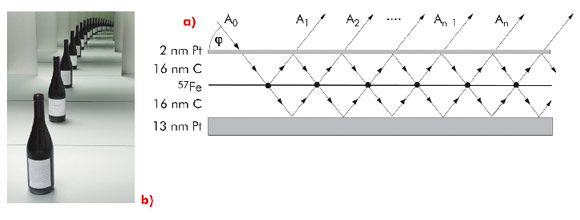- Home
- Users & Science
- Scientific Documentation
- ESRF Highlights
- ESRF Highlights 2010
- Dynamics and extreme conditions
- The collective Lamb shift in single photon superradiance
The collective Lamb shift in single photon superradiance
The interaction of many identical two-level atoms with a common radiation field leads to a profound modification of the temporal, directional and spectral characteristics of their collective emission compared to that of a single atom. A prominent example is the phenomenon of superradiance that manifests itself as a strong acceleration of the collective spontaneous emission [1]. It was predicted that the superradiant emission of light goes along with a radiative shift of the atomic transition energy, the collective Lamb shift [2]. In the optical regime this effect appeared to be extremely difficult to observe due to atom-atom interactions and multiple scattering effects.
Here we explore the manifestation of superradiance and the collective Lamb shift in the regime of hard X-rays by employing the Mössbauer isotope 57Fe (resonance energy 14.4 keV, natural linewidth 4.7 neV) as a two-level system. Our approach does not only circumvent the intrinsic problems of previous approaches, but also provides a sufficiently high spectral resolution to detect small energy shifts.
To understand the collective Lamb shift we first look at the single-atom Lamb shift. The emission and reabsorption of virtual photons within the same atom leads to a small correction to its transition energy, also known as self-energy. The observation and explanation of this shift (for atomic hydrogen) paved the way for the development of quantum electrodynamics as the unified theory of light-matter interaction. Willis E. Lamb received the Nobel Prize in Physics in 1955 for his discovery.
If the atom is now surrounded by an ensemble of identical atoms, the emitted photon may be absorbed not only by the same atom but also by identical atoms within the ensemble. Considering such an ensemble of identical atoms as a ‘giant’ atom, the emission and reabsorption of photons within the ensemble itself again leads to a (complex-valued) self-energy correction of the transition energy. The real part of this quantity is the collective Lamb shift, the imaginary part is the superradiant decay width.
In order to prepare a superradiant ensemble of atoms we have embedded ultrathin layers of 57Fe in a planar cavity to resonantly excite them with synchrotron radiation pulses, coupled evanescently into the first-order guided mode (Figure 4a). The cavity geometry exhibits important features that facilitate the observation of the collective Lamb shift. First, the ensemble of atoms appears to be optically thin upon absorption. Second, multiple reflections of the radiation within the cavity render the ensemble of atoms to be optically thick, comparable to multiple images of an object between two parallel mirrors (Figure 4b). Thus, the optical thicknesses of the sample for absorption and emission are decoupled, which is an important condition for the observation of superradiance.
The measured signal in the experiment is the reflected radiation from the cavity, i.e. the superposition of all partial waves Ai in Figure 4a. In this geometry, the ensemble of 57Fe atoms was excited into a purely superradiant state that decayed almost two orders of magnitude faster than a single atom. For the spectral analysis of the reflected radiation, a resonant single-line 57Fe analyser foil was employed that was mounted on a Doppler drive typically used in Mössbauer spectroscopy. The transmission through the foil was recorded as function of the Doppler shift. The resulting energy spectra for two samples containing 57Fe layers of 0.6 nm and 1.2 nm thickness are shown in Figure 5a and b, respectively. Both curves are broadened far beyond the natural decay width of Γ0 = 4.7 neV, reflecting the superradiant nature of the emission. One clearly observes a spectral shift of the centre of mass of the spectra towards lower energies. This is the collective Lamb shift. The measured data are in excellent agreement with calculations (solid red lines).
 |
|
Fig. 5: Energy spectra of the two cavity samples containing ultrathin layers of a) 0.6 nm and b) 1.2 nm 57Fe. The shift of the centre of mass of these curves is the collective Lamb shift. |
This experiment, carried out at beamline ID22N, has demonstrated a simple way to observe superradiance and the collective Lamb shift in the X-ray regime. This approach opens a new window to systematically explore cooperative effects in the interaction of light and matter with very high precision.
Principal publication and authors
R. Röhlsberger (a), K. Schlage (a), B. Sahoo (a), S. Couet (b) and R. Rüffer (c), Science 328, 1248 (2010).
(a) Deutsches Elektronen Synchrotron DESY, Hamburg (Germany)
(b) Instituut voor Kern- en Stralingsfysica, Katholieke Universiteit Leuven (Belgium)
(c) ESRF
References
[1] R.H. Dicke, Phys. Rev. 93, 99 (1954).
[2] R. Friedberg, S.R. Hartmann, and J.T. Manassah, Phys. Rep. C 7, 101 (1973).




